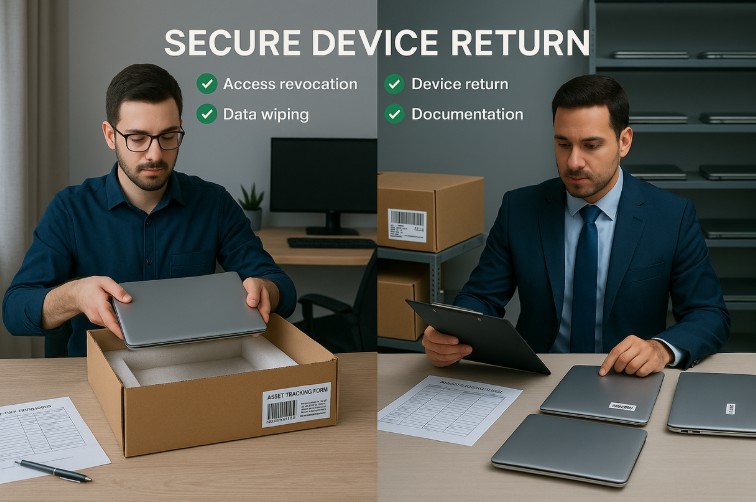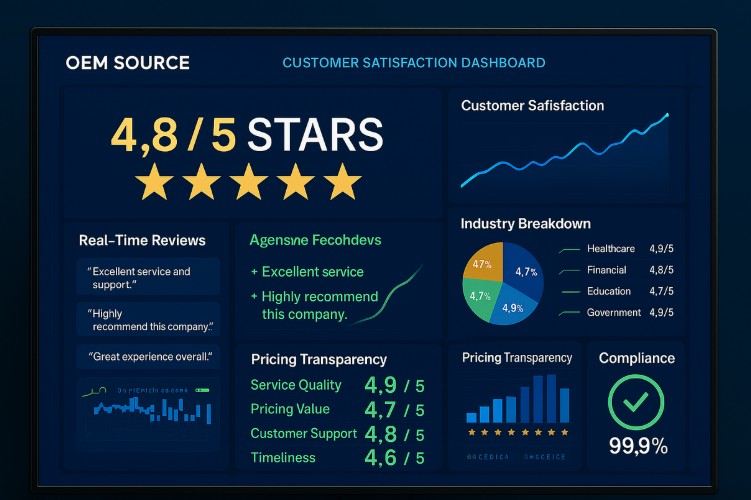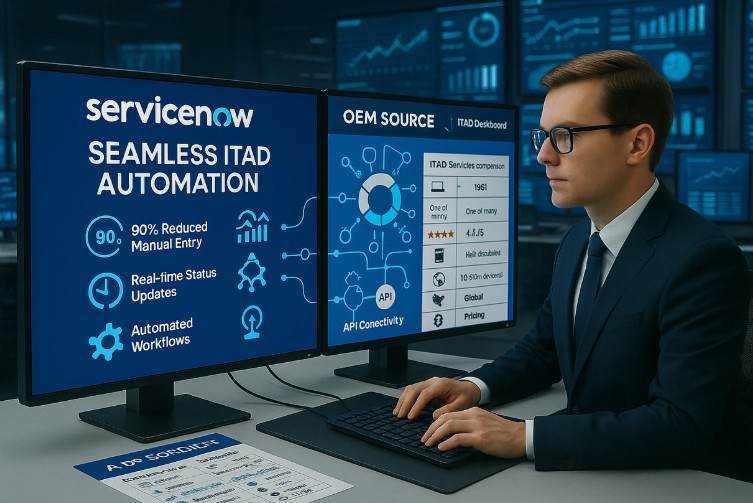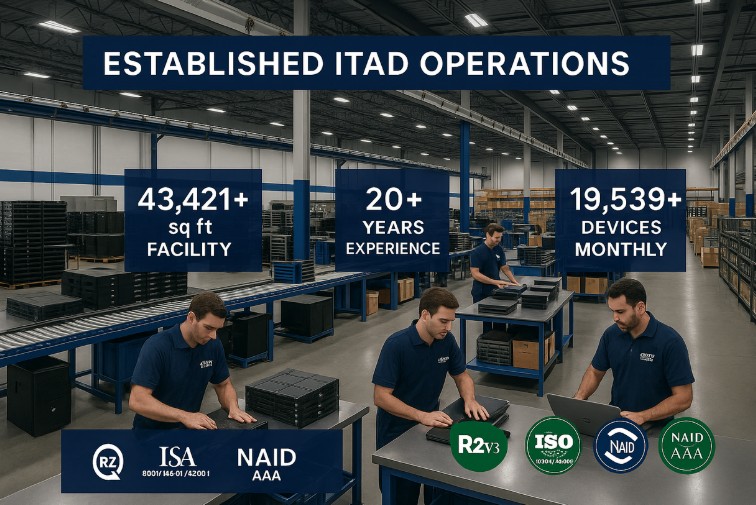In an era where nearly half of all companies lose at least 5% of their devices during employee offboarding, the financial and security implications of ineffective laptop retrieval have become a multi-million-dollar problem. A recent ESET study found that 56% of second-hand corporate network devices still contained sensitive company data, including VPN credentials and hashed passwords. This isn’t just a logistical challenge; it’s a ticking time bomb of potential data breaches and regulatory fines.
As remote work becomes the new normal, the need for a secure and standardized laptop offboarding process has never been more critical. This comprehensive guide provides a step-by-step roadmap for creating an effective laptop offboarding program that ensures data security, maintains regulatory compliance, and protects your organization from unnecessary risk.
Why Laptop Offboarding Matters in Remote Work Environments
Effective laptop offboarding is a cornerstone of modern IT security, particularly in remote work environments where physical oversight is limited. With 41% of data breaches originating from lost or stolen devices, the financial and reputational risks of improper device management are substantial. A structured offboarding process not only mitigates these security risks but also ensures compliance with data protection regulations like GDPR and HIPAA.
Organizations with standardized offboarding are up to 40% more likely to successfully rehire former employees demonstrating that positive offboarding experiences benefit talent acquisition and brand reputation. In an environment where 66% of data breaches originate from insider threats, including former employees with lingering system access, a secure offboarding process is a critical business imperative.
Step-by-Step Laptop Offboarding Process for Data Security and Compliance
Creating a standardized and repeatable laptop offboarding process is essential for ensuring data security and regulatory compliance. The process should begin the moment an employee’s departure is confirmed and should follow a clear, documented workflow that leaves no room for error.
- Revoke Employee Access to Systems and Applications
The first and most critical step is to immediately revoke the departing employee’s access to all company systems and applications. This includes everything from email and internal communication platforms to CRM software and cloud-based solutions.
Key access revocation steps include:
- Deactivating User Accounts: Immediately disable all user accounts associated with the departing employee
- Resetting Passwords: Change passwords for any shared accounts the employee may have had access to
- Revoking Software Licenses: Reclaim software licenses to reduce costs and prevent unauthorized use
- Terminating Remote Access: Disable VPN and other remote access credentials to prevent continued entry to company networks
- Conduct Secure Data Wipes on Devices
Once the laptop has been retrieved, perform a secure data wipe to permanently remove all sensitive information. This step should follow industry standards such as NIST 800-88 to ensure data is completely unrecoverable. For organizations with elevated security needs, working with a certified data destruction provider helps ensure compliance and peace of mind.
- Define and Communicate Asset Recovery Policies
Clear and consistent communication is essential for smooth and successful device recovery. Your organization should maintain a written policy that outlines the employee’s responsibilities for returning all company-issued assets, including laptops, mobile devices, and accessories.
The asset recovery policy should include:
- Return Timeline: Specific deadlines for asset return
- Return Instructions: Clear directions, including packaging requirements and pre-paid shipping labels if applicable
- Non-Compliance Consequences: A clear outline of financial liability or legal implications if the equipment is not returned
The Role of Automation in Streamlining Laptop Offboarding
Automation plays a crucial role in creating an efficient and scalable laptop offboarding process. By automating routine tasks, organizations can reduce human error, maintain consistency, and free up their IT team to focus on their higher-priority initiatives.
Automated Communication Improves Return Rates
Automated communication tools can send timely reminders to departing employees about the asset recovery process. These messages can include step-by-step return instructions, pre-paid shipping labels, and links to the organization’s asset recovery policy. Automation improves the employee experience while significantly increasing the likelihood of a successful and timely device return.
Track Laptop Returns in Real Time
Modern offboarding solutions offer real-time tracking of device returns, allowing IT teams to monitor each laptop from employee departure through receipt at company facilities. This visibility supports a clear chain of custody and reduces the chances of lost or delayed shipments. According to recent research, 33% of device retrievals encounter delivery issues—making real-time tracking a critical feature in any offboarding program.
Addressing Compliance and Data Security During Offboarding
Compliance and data security must remain top priorities throughout the laptop offboarding process. A single oversight can result in financial penalties, reputational damage, and legal consequences. Standardizing offboarding workflows and implementing enterprise-grade protections creates a defensible, audit-ready program.
Use Enterprise-Grade Security Protocols
Enterprise-grade protocols are essential for protecting sensitive data during offboarding. These protocols should include:
- Full-disk encryption: Use tools like BitLocker or FileVault
- Multi-factor authentication: For all system access
- Certified data wiping tools, Such as Blancco Drive Eraser or DBAN, to ensure permanent data removal
Prevent Unauthorized Access Post-Departure
Immediately revoking access to all systems and applications is the most effective way to prevent unauthorized data access after an employee’s departure. This includes deprovisioning user accounts, resetting shared account passwords, disabling VPN credentials, and reclaiming software licenses.
Create a Standardized Offboarding Checklist
A standardized checklist ensures that every step of the offboarding process is executed consistently and securely. This documented process also supports internal audits and external compliance reviews.
Key checklist elements include:
- Access Revocation: Confirm all user access has been terminated
- Asset Recovery: Track the return of company-issued laptops and devices
- Data Wiping: Verify all data has been securely erased
- Documentation: Maintain records for every stage of the process
- Final Verification: Confirm all checklist items have been completed
Advantages of a Standardized Offboarding Workflow
Standardizing the offboarding process provides several benefits:
- Improved consistency across employee exits
- Lower risk of human error or missed steps
- Stronger compliance with data protection regulations
- Enhanced data security and IT resource efficiency
Utilizing Advanced Offboarding Tools
Advanced offboarding tools simplify laptop retrieval, automate communication, and enhance security. These tools offer a centralized dashboard to manage offboarding workflows from end to end.
Key Features of Effective Offboarding Solutions
When evaluating laptop offboarding solutions, look for platforms that include:
- Automation capabilities for email notifications and reminders
- Secure integration with HR and IT systems
- Real-time tracking dashboards for returned devices
- Comprehensive compliance reporting for audits and documentation
Case Study: Streamlining Laptop Retrieval with Deel IT
Deel IT is an end-to-end offboarding solution designed to improve laptop recovery efficiency and reduce compliance risks. By automating communication and enabling real-time tracking, Deel IT has helped organizations reduce offboarding timelines, lower costs, and maintain stronger data security standards.
Reducing Risks Associated with Improper Device Management
Improper device management can expose organizations to serious risks, including data breaches, regulatory fines, and unnecessary financial losses. Without a secure and standardized process, even a single unreturned or unsanitized device can become a costly liability. Implementing a structured offboarding protocol helps mitigate these threats and safeguard both your data and your reputation.
Common Risks and Their Impact
- Data Breaches: Unauthorized access to sensitive company data due to unretrieved or unsanitized devices
- Regulatory Fines: Legal penalties for non-compliance with data protection regulations such as GDPR, HIPAA, or FACTA
- Financial Losses: The cost of replacing unreturned laptops, as well as potential legal and remediation expenses
- Reputational Damage: Long-term erosion of customer trust and brand credibility following a security incident
Proven Strategies for Risk Mitigation
Effective risk mitigation strategies include implementing a standardized offboarding process, automating routine tasks to reduce human error, using certified data wiping tools to permanently remove all data from returned devices, and partnering with a certified ITAD vendor for secure disposal.
For comprehensive asset management, consider a corporate IT asset disposition program covering data sanitization to value recovery.
Make Laptop Offboarding a Security Asset, Not a Liability
Laptop offboarding is a core component of your organization’s data security, compliance posture, and operational integrity. A single lapse in the process can result in data exposure, regulatory penalties, or lost hardware. By proactively implementing a standardized, secure, and automation-driven offboarding strategy, your team can reduce risk, recover value, and reinforce your company’s reputation as a responsible digital steward.
Ready to strengthen your offboarding workflows and eliminate risk exposure?
Partner with OEM Source to implement a compliant, secure, and fully auditable laptop offboarding solution. From data sanitization to certified ITAD services, we help enterprises like yours protect sensitive data, streamline asset recovery, and meet the highest standards in security and sustainability.
Frequently Asked Questions
What is the first step in the offboarding process?
The first and most critical step is to immediately revoke the departing employee’s access to all systems, applications, and remote networks. This reduces the risk of data breaches and ensures sensitive information remains secure.
How can you ensure that all data is removed from a returned laptop?
Use a certified data wiping tool that complies with industry standards like NIST 800-88 to permanently remove all data. This ensures devices are sanitized and safe for reuse, resale, or recycling.
What is the best way to track laptop returns during offboarding?
Implement an offboarding solution with real-time tracking capabilities to monitor each device from employee departure to physical return, ensuring a clear chain of custody and minimizing the risk of loss in transit.
How can organizations improve their offboarding success rates?
Organizations can improve outcomes by standardizing processes, automating communications, and partnering with certified ITAD vendors to manage secure disposal and compliance reporting.
What role does documentation play in laptop offboarding?
Documentation is key for both security and compliance. Maintain records of access revocation, asset return, data sanitization, and vendor handling to ensure audit-readiness and demonstrate regulatory compliance.





